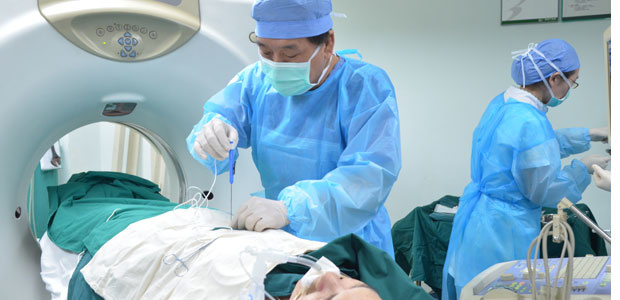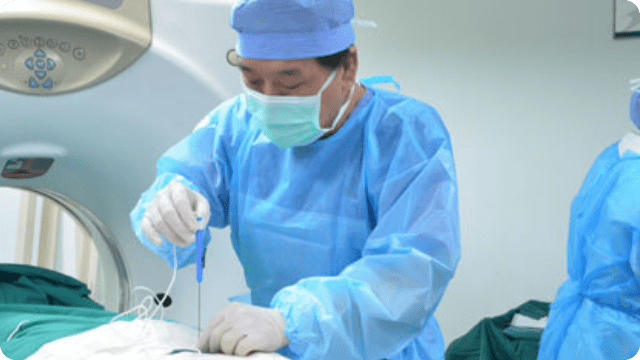 Views:80
Views:80 2025-01-08
2025-01-08 Share
Share
Applicable diseases:
Pancreatic cancer, liver cancer, lung cancer, kidney cancer, prostate cancer and other solid tumors, especially for tumors near the hilar area, gallbladder, bile duct, pancreas, and ureterTechnology advantages:
Short ablation time, safe and controllable process, without affecting the important tissues and quick recovery of function, adaptable to a variety of complex medical conditions
What’s Nanoknife?
Nanoknife is a brand-new cutting-edge ablation technology for tumor treatment. Derived from Irreversible Electroporation (IRE), it breaks the membrane of tumor cells with high voltage pulses from electrode probes, resulting in multiple irreversible nano-meter electroporated holes. Thus, it destroys the balance in and between tumor cells and accelerates their death.

Clinical Application of Nanoknife
Nanoknife was approved by US FDA into clinical use and has passed EU CE accreditation. In recently years, it has been successively put into clinical use in over 100 core cancer hospitals around the world, including China, whose Ministry of Health approved in June, 2015 the use of this technology in cancer treatment.
Advantages of Nanoknife
1. Short course of ablation
To ablate a solid tumor of 3cm in diameter, 5 minutes is more than enough. Every pair of probes releases 90 microsecond ultra-short pulses, which takes less than one minute. Even if there are 3-4 overlapped ablation areas, some patients can still be discharged the same day or next day after the whole process.
2. Vessels, nerves and other vital tissues in the ablated area are well protected.
Another advantage of nanoknife ablation is that it causes in the ablated area no irreversible damage to important tissue structures like vessels, bile duct, nerves and ureter, etc.. All important tissue structures within liver, such as artery, vein, portal vein, bile duct, etc. will be well reserved after nanoknife operation.
3. Non-thermal ablation
The ablation of nanoknife breaks cell membrane using mainly electrical pulses, without creating thermal energy during the process, while traditional ablation uses temperature alternation to cause protein denaturation, damaging all kinds of protein and DNA, and consequently makes above mentioned tissue structures irreparable. Moreover, if there are major vessels in the ablated area, the thermal energy of traditional ablation will be taken away by the bloodstream and the ablation effect will be weaken, thus, recurrence is more likely to happen.
4. Thorough treatment, clear boundary
Another advantage of nanoknife is that its ablation can completely cover the tumor no matter where it is located and in what sizes and shape. Meanwhile, after ablation, there is clear boundary between the ablated and unablated area, which means no residual lesion and therefore lower risk of recurrence.
5. Normal cells occupy the ablated area shortly to restore its normal function
Traditional ablation use temperature alternation to trigger protein denaturation, resulting in coagulative necrosis, after which no tissue structure in the area survives. On the contrary, nanoknife is to induce death of tumor cells and use phagocytosis of immune cells of human body to eliminate the dead tissues, thus to repair and regenerate normal tissues.
6. Real-time monitoring on the process
Nanoknife treatment can be guided and monitored under ultrasound, CT and MRI. With assistance of these equipments, the nanoknife probes are located, process and actual range of ablation area are monitored in real time. Thus, doctors can observe the changes of the ablated area and around tissues to ensure the treatment effect, safety and quick recovery afterwards.
7. Adaptable to more complicated situations
Traditional ablation is impracticable to situations when the tumor involves major vessels, bile duct, pancreiatic duct, portal vein and other vital areas. Moreover, there is high risk of damaging nerves and causing paralysis, loss of sexual ability and other consequences in using traditional ablation to treat prostate tumor or tumor near the spine. On the contrary, nanoknife does no harm to the ducts and nerves, therefore it is practicable to above mentioned situations and plays an irreplaceable role in treating patients of this kind.
Adaptable to illnesses
Illnesses can be treated with nanoknife include tumors in pancreas, liver, lung, kidney, prostate, etc.. It is of particular advantages in dealing with tumors involving porta hepatis, gallbladder, bile duct, pancreas and ureter.
Cautions
1. During the process, general anesthesia and tracheal intubation are needed. Because the released millisecond high-voltage electrical pulses may cause muscle vibration, muscle relaxants are also required.
2. For patients who have near the tumor implanted metal objects, including stents, radioactive particles, heart pacemaker etc. and those who have arrhythmia or have recently experienced myocardial infarction, nanoknife is impracticable.
 Prostate cancer
Prostate cancer- Mr.Chen
- Malaysiamore than 1 year
Mr.Chen was diagnosed prostate cancer, the local doctor suggested him to undergo a direct resection, but Mr.TING wanted to live a life like normal peop...


 (MY)+60 10-898 8919
(MY)+60 10-898 8919

























